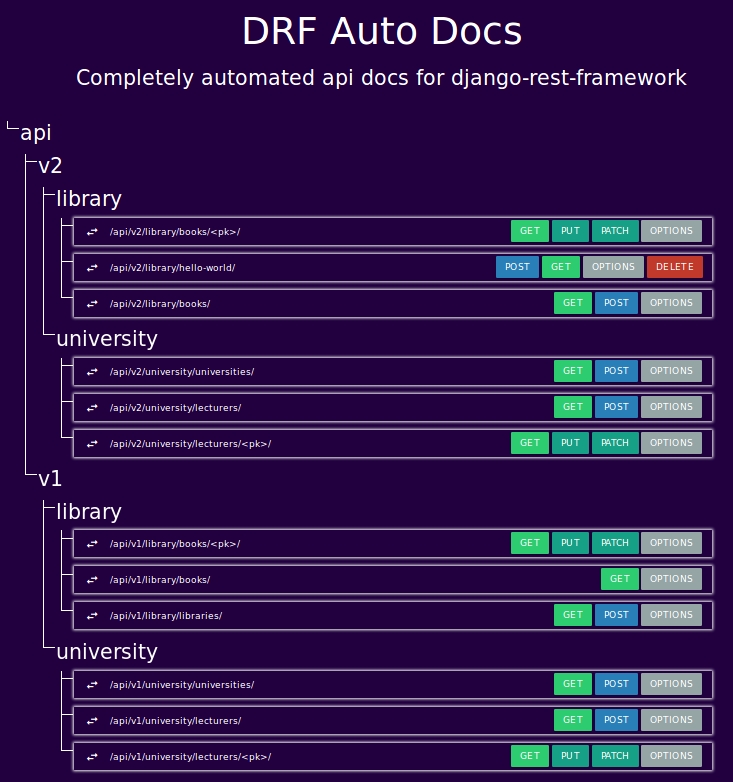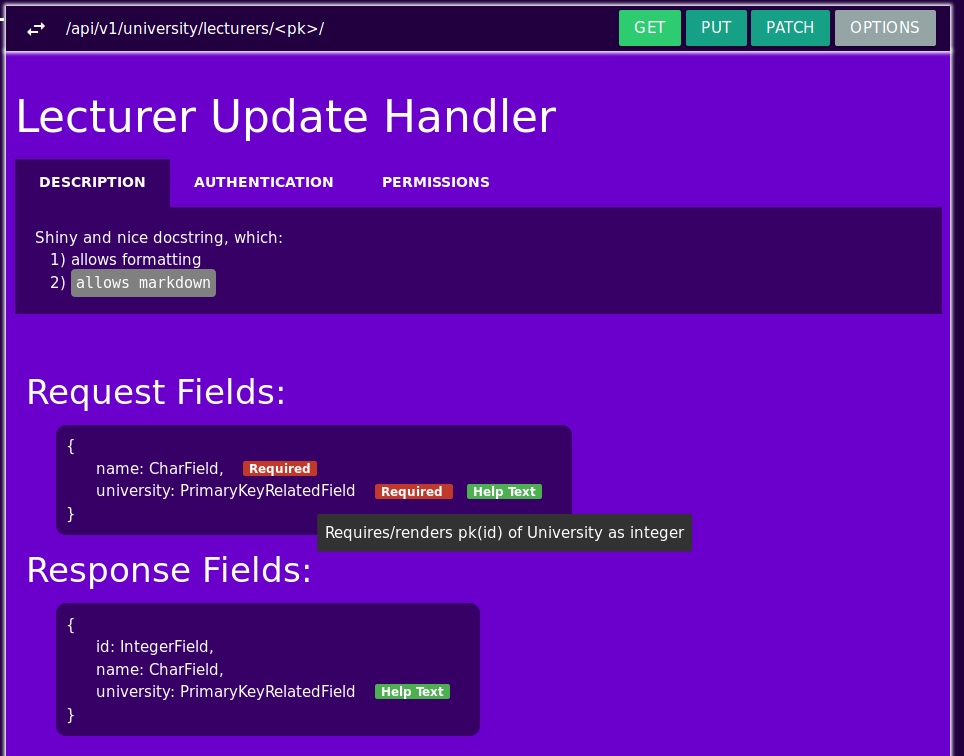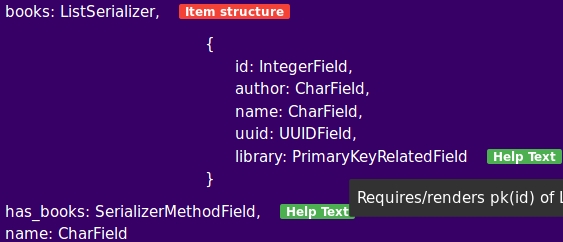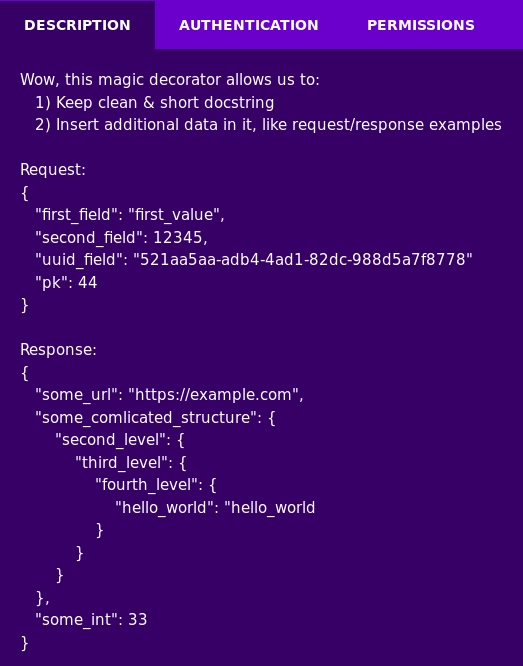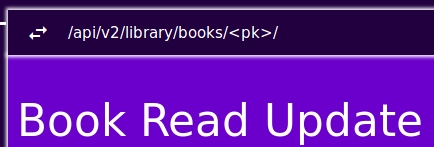THIS REPO IS NO LONGER MAINTAINED. PLEASE CONSIDER OTHER AUTOMATED DOCUMENTATION PACKAGES
Automated api documentation renderer
- optional response_serializer_class, if output serializer is different from input serializer
- fully-documented functional views
- tree-like structure
- Docstrings:
- markdown
- preserve space & newlines
- formatting with nice syntax
- Fields:
- different fields for request/response, based on read-/write-only attributes and whether response_serializer_class presented or not
- choices rendering
- help_text rendering (to specify SerializerMethodField output, etc)
- Endpoint properties:
- filter_backends
- authentication_classes
- permission_classes
- extra url params(GET params)
- viewsets
- possibility to try in browser
@format_docstring(request_example, response_example=response_example)
class BookReadUpdateHandler(RetrieveUpdateAPIView):
"""
Wow, this magic decorator allows us to:
1) Keep clean & short docstring
2) Insert additional data in it, like request/response examples
Request: {}
Response: {response_example}
"""In virtualenv:
pip install drf_autodocs
In settings:
INSTALLED_APPS = [
...
'drf_autodocs',
...
]
In your urls:
urlpatterns = [
...
url(r'^', include('drf_autodocs.urls')),
]
That's already enough for swagger-like docs, result available on
localhost:8000/docs/
If you want functional views support and some more features, read below.
Tree-like structure is built from url prefixes. To make your endpoints grouped by some category, you must include your urls within other url. There are, generally, 2 ways to achieve it:
Example 1:
university_urlpatterns = [
url(r'^lecturers/', university_views.LecturersHandler.as_view(), name='lecturers'),
url(r'^lecturers/(?P<pk>\d+)/$', university_views.LecturerUpdateHandler.as_view(), name='lecturer_read_update'),
url(r'^universities/', university_views.UniversitiesHandler.as_view(), name='universities'),
]
urlpatterns = [
url(r'^library/', include(library_urlpatterns, namespace='library')),
url(r'^university/', include(university_urlpatterns, namespace='university')),
]Example 2:
urlpatterns = [
url(r'^library/', include(library_urlpatterns, namespace='library')),
url(r'^university/', include([
url(r'^lecturers/', university_views.LecturersHandler.as_view(), name='lecturers'),
url(r'^lecturers/(?P<pk>\d+)/$', university_views.LecturerUpdateHandler.as_view(), name='lecturer_read_update'),
url(r'^universities/', university_views.UniversitiesHandler.as_view(), name='universities')
], namespace='university')),
]Say you have a view like this:
class BookReadUpdateHandler(RetrieveUpdateAPIView):
serializer_class = BookUpdateSerializer
queryset = Book.objects.all()And say this serializers' input is different from output:
class BookUpdateSerializer(serializers.ModelSerializer):
class Meta:
fields = ('name', 'author')
model = Book
def to_representation(self, instance):
return LibrarySerializer(instance.library)Now to know what return format is, one must make a request. This package simplifies it via:
response_serializer_class = YourSerializer
Now your view looks like:
class BookReadUpdateHandler(RetrieveUpdateAPIView):
"""
Shiny and nice docstring, which:
1) allows formatting
2) `allows markdown`
"""
serializer_class = BookUpdateSerializer
response_serializer_class = LibrarySerializer
queryset = Book.objects.all()from .request_response_examples import request_example, response_example
from drf_autodocs.decorators import format_docstring
@format_docstring(request_example, response_example=response_example)
class BookReadUpdateHandler(RetrieveUpdateAPIView):
"""
Wow, this magic decorator allows us to:
1) Keep clean & short docstring
2) Insert additional data in it, like request/response examples
Request: {}
Response: {response_example}
"""
serializer_class = BookUpdateSerializer
response_serializer_class = LibrarySerializer
queryset = Book.objects.all()Please think twice before using such parameters, as they might be unneeded.
But if you really need them, here you go:
class LibrariesHandler(ListCreateAPIView):
"""
Shiny and nice docstring, which:
1) allows formatting
2) `allows markdown`
"""
extra_url_params = (('show_all', 'Bool', 'if True returns all instances and only 5 otherwise'),
('some_extra_param', 'Integer', 'Something more to be included there'))Results in:
For functional views, decorate them with.
drf_autodocs.decorators.document_func_view
Now you can insert into view via kwargs:
- serializer_class
- response_serializer_class
- filter_backends
- authentication_classes
- permission_classes
- doc_format_args
- doc_format_kwargs
Now it should look like:
from drf_autodocs.decorators import document_func_view
format_args = ['"This string\nwas inserted"',]
@document_func_view(serializer_class=BookSerializer,
response_serializer_class=LibrarySerializer,
doc_format_args=format_args)
@api_view(['GET', 'POST', 'DELETE'])
def hello_world(request):
"""
Works for `functional` views too!
Yeah, that thing rocks!
And allows formatting {}
"""
return Response('hello_world response')This package uses default DRF field attribute help_text
If you're using ModelSerializer, and model field got help_text attr, it will be
transferred to your serializers' field automatically.
Example:
from rest_framework import serializers
has_books = serializers.SerializerMethodField(help_text='returns Bool')Note that specifying help_text on serializers' field overrides the one from model
To change application look & feel, override templates and/or static files.
Root template is :
templates/drf_autodocs/index.html
For additional parsers(if you want other structure than tree), inherit from
drf_autodocs.parser.BaseAPIParser
Endpoint names could use view names or url names, replacing '_' and '-' with ' ' and capitalizing output.
Default behavior is to use url names:
url(r'^books/(?P<pk>\d+)/$', library_views.BookReadUpdateHandler.as_view(), name='book_read_update'),
will result in:
If you want to use endpoint(view) names instead, do this in settings:
AUTODOCS_ENDPOINT_NAMES = "view"
- Python 3
- Django 1.8+
- Django Rest Framework 3+
Thanks to django, django-REST for their awesome work, and drf-docs for source of inspiration as well as some parts of code.
Developed with care by Mashianov Oleksander at
If you 👍 this, don't forget to ⭐ it and share with friends.
